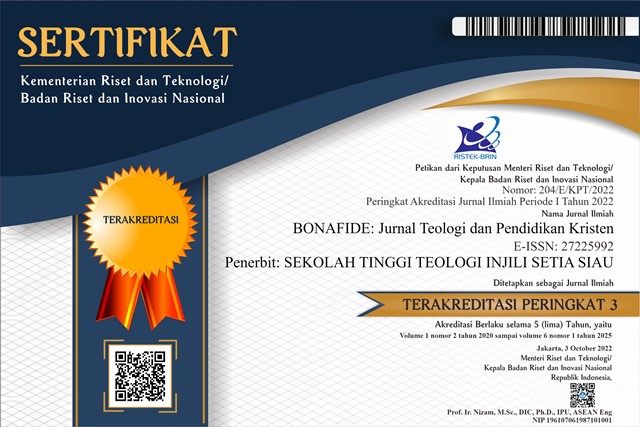THE INFLUENCE OF GADGETS ON STUDENTS' LEARNING MOTIVATION AT STATE PRIVATE MIDDLE SCHOOL 1 SIAU WEST SOUTH
Abstract
The use of gadgets among students of SMP Negeri 1 Siau Barat Selatan is a witness to change in student learning behavior and technological advances. This research aims to explore this, focusing on the negative impact of gadget use on students' learning motivation. This research identifies gadget usage patterns, analyzes their impact on learning motivation, and presents recommendations for more effective management in educational environments. The research method used was quantitative, involving students from South West Siau 1 Middle School as samples. The research results show that gadget use tends to be intense, involving many students in various activities. Data analysis shows a negative relationship between the intensity of gadget use and student learning motivation. Factors such as distraction, dependence on social media, and lack of time management are the main causes of low learning motivation. The rationale for this research was built by referring to the theory of learning motivation, the theory of the use of technology in education, and the theory of adolescent development. The proposed hypothesis strengthens the finding that the intensity of gadget use is negatively correlated with the level of student learning motivation. This research contributes to an in-depth understanding and treatment of the impact of gadget use in educational contexts. It is hoped that the findings of this research can guide educational institutions, parents, students, and future researchers in managing the use of gadgets so that they do not hinder students' learning motivation.
References
Anderman, Eric M, dan Lynley H Anderman. 2020. Classroom Motivation: Linking Research to Teacher Practice. Routledge.
Creswell, J. David, dan John W. Creswell. 2017. Research Design: Qualitative, Quantitative, and Mixed Methods Approaches. Newbury Park, California: SAGE Publications.
Dutton, William, Kris Pister, Hal Varian, Rob Bernard, Rob Salkowitz, Jacques Bughin, Michael Chui, dan James Manyika. 2010. “Clouds, Big Data, and Smart Assets: Ten tech-enabled Business Trends to Watch.” McKinsey Quarterly, no. 4: 75–86.
Gradisar, Michael, Amy R. Wolfson, Allison G. Harvey, Lauren Hale, Russell Rosenberg, dan Charles A. Czeisler. 2013. “The Sleep and Technology Use of Americans: Findings from the National Sleep Foundation’s 2011 Sleep in America poll.” Journal of Clinical Sleep Medicine 9, no. 12: 1291–99. https://doi.org/10.5664/jcsm.3272.
Hinduja, Sameer, dan Justin W. Patchin. 2010. “Bullying, Cyberbullying, and Suicide.” Archives of Suicide Research 14, no. 3: 206–21. https://doi.org/10.1080/13811118.2010.494133.
Hysing, Mari, Ståle Pallesen, Kjell Morten Stormark, Reidar Jakobsen, Astri J. Lundervold, dan Børge Sivertsen. 2015. “Sleep anLd Use of Electronic Devices in Adolescence: Results from A Large Population-Based Study.” BMJ Open 5, no. 1. https://doi.org/10.1136/bmjopen-2014-006748.
Kaplan, Andreas M., dan Michael Haenlein. 2010. “Users of the World, Unite! The Challenges and Opportunities of Social Media.” Business Horizons 53, no. 1: 59–68. https://doi.org/10.1016/j.bushor.2009.09.003.
Katz, James Everett, dan Mark Aakhus. 2002. Perpetual Contact: Mobile Communication, Private Talk, Public Performance. Cambridge University Press.
Mark, Gloria, Daniela Gudith, dan Ulrich Klocke. 2008. “The Cost of Interrupted Work: More Speed and Stress.” In Proceedings of the SIGCHI conference on Human Factors in Computing Systems, 107–10.
Maslow, Abraham. 1974. A Theory of Human Motivation. Lulu.com.
Pintrich, Paul R., dan Elisabeth V. De Groot. 1990. “Motivational and Self-Regulated Learning Components of Classroom Academic Performance.” Journal of Educational Psychology 82, no. 1: 33–40. https://doi.org/10.1037/0022-0663.82.1.33.
Primack, Brian A., Ariel Shensa, Jaime E. Sidani, Erin O. Whaite, Liu yi Lin, Daniel Rosen, Jason B. Colditz, Ana Radovic, dan Elizabeth Miller. 2017. “Social Media Use and Perceived Social Isolation Among Young Adults in the U.S.” American Journal of Preventive Medicine 53, no. 1: 1–8. https://doi.org/10.1016/j.amepre.2017.01.010.
Ravizza, Susan M., Mitchell G. Uitvlugt, dan Kimberly M. Fenn. 2017. “Logged In and Zoned Out: How Laptop Internet Use Relates to Classroom Learning.” Psychological Science 28, no. 2: 171–80. https://doi.org/10.1177/0956797616677314.
Reeve, Johnmarshall. 2012. “A Self-Determination Theory Perspective on Student Engagement.” In Handbook of Research on Student Eengagement, 149–72. Springer.
Rüpke, L. 2013. Gadgets: A Sociological Theory of Technology. Routledge.
Szeto, Grace P.Y., Leon Straker, dan Sally Raine. 2002. “A Field Comparison of Neck and Shoulder Postures in Symptomatic and Asymptomatic Office Workers.” Applied Ergonomics 33, no. 1: 75–84. https://doi.org/10.1016/S0003-6870(01)00043-6.
Turkle, Sherry. 2011. “Alone Together: Why We Expect More from Technology and Less from Each Other.” Basic Books.
Wentzel, Kathryn R, dan David B Miele. 2009. Handbook of Motivation at School. Routledge.
Copyright (c) 2023 Anggris Oktavianus Katiandagho

This work is licensed under a Creative Commons Attribution-ShareAlike 4.0 International License.









 This work is licensed under a
This work is licensed under a 